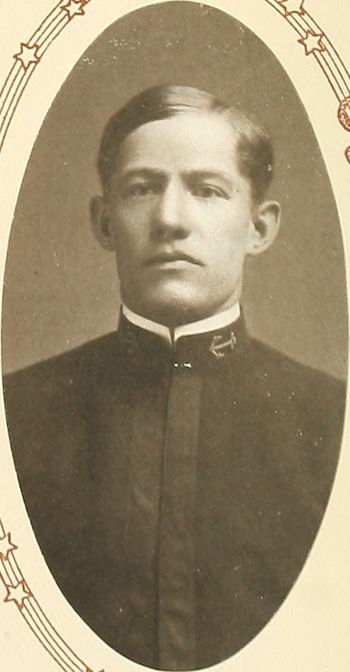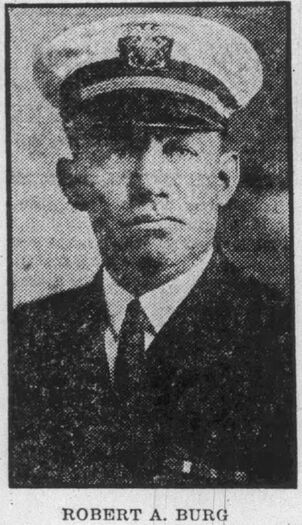ROBERT A. BURG, CDR, USN
Robert Burg '08
Lucky Bag
From the 1908 Lucky Bag:
ROBERT ANDREW BURG
Grand Island, Nebraska
"Bobbie"
"Hear the latest? Fletcher says we get two months' leave!
A fleet-footed cherub who has run as well as talked his way through the Academy. Has run everything from the hundred-yard dash and the instructor to a free-lunch counter—poco rolls only. Vice-President and chief talker of the gossip club.
"Boatswain's mate! wake up the sailors."
Track Team (4, 3, 2), Captain (1). Hustlers (2, 1). Gym Team (4).

ROBERT ANDREW BURG
Grand Island, Nebraska
"Bobbie"
"Hear the latest? Fletcher says we get two months' leave!
A fleet-footed cherub who has run as well as talked his way through the Academy. Has run everything from the hundred-yard dash and the instructor to a free-lunch counter—poco rolls only. Vice-President and chief talker of the gossip club.
"Boatswain's mate! wake up the sailors."
Track Team (4, 3, 2), Captain (1). Hustlers (2, 1). Gym Team (4).
Loss
Robert was lost on September 26, 1926 of injuries sustained in an aircraft crash near London. He was a Naval Attaché in London.
Other Information
From researcher Kathy Franz:
On May, 23, 1903, Robert was on the Nebraska State track team which had a competition with the Kansas State Jayhawks at Lawrence. Per The Lincoln Star of May 25: “It was the biggest steal I ever witnessed and Nebraska should have won by at least twenty points,” said Robert Burg, a member of the team. . . .”Those fellows beat anything I ever saw and nothing that we won escaped without a wrangle and 'protest' from the Kansas team.
“We came near having a repetition of the free-for-all fight that the baseball team was forced to take part in and were ready for the fray. The boys all had their spiked shoes off to use as weapons and were prepared to fight if necessary, because the Kansas supporters were using us rather roughly and seemed on the point of letting their threats and yells of derision give way to actions. Dr. Clapp was disgusted with the manner in which we were treated and thought it was anything but showing the proper college spirit. He declared that if he had understood the conditions he would not have allowed the team to visit Kansas.”
Per the Omaha Daily Bee, July 17, 1904: “Robert Andrew Burg, recently appointed cadet to the United States academy at Annapolis, Md., is a son of Andrew Burg of Grand Island, Neb. He was chosen as first alternate by Congressman Norris last April. Determined to win, he went to Annapolis for preparation two months ago. In the very rigid examination closing June 29 the principal failed, but young Burg passed both mental and physical examinations with high honors. He is the first from Grand Island to gain admission to the Naval academy. For two years past he was a student in the State university at Lincoln. He became a great favorite with the Sigma Chi fraternity and represented it at the field day exercises, winning the 100-yard and 200-yard races.”
In May 1907, Robert took first place in the 220 yard dash and the 220 yard hurdle race and was second in the 100 yard dash and broad jump. He was named captain of the Naval Academy's Field and Track Team for the next season.
The May 1908 issue of Leslie's magazine had a picture of Robert. In July he reported to the battleship Connecticut stationed in San Francisco.
Robert married Alice Claire Elliott on September 16, 1917, in Massachusetts.
The next February, Robert was at the Fore River yard and had the oversight and inspection of the government's ship building operations.
On September 20, 1919, Robert was in charge of a fleet of three submarines that left Hampton Roads and arrived off the bar at the mouth of Cape Fear. The Eagle 25 led the group, and hundreds of Wilmington citizens greeted the flotilla's arrival. Citizens were able to visit the ships over the next two days.
From Find A Grave:
Lieut. Cmmdr. R. A. Burg, USN, designated Naval Aviator #2961 in 1921. USNA, Class of 1908. Victim of aircraft accident, England.
Burial took place on Oct. 11, 1926.
Grand Island Daily independent Monday 27 September 1926 p. 1
Robert Burg Passes Away
Burns and Other Injuries Suffered in Aerial Crash Fatal
Ends Life Of Service
Tentative Plans Call for Return of Body to Grand Island for Burial — Companion in tragic Flight Leaves the Hospital
London, Sept. 27. (AP)—Commander Robert A. Burg, U.S.N., died yesterday at Purley hospital of injuries received in an airplane accident last Tuesday. Major Clarence L. Tinker, U.S.A., also injured has recovered sufficiently to be removed from the hospital today.
Both officers, attached for aviation at the American embassy in London, were injured when their plane crashed into a tree near Caterham, in Surrey, and burst into flames.
Mrs. Andrew Burg received the sad news of the death of her son, Lieutenant Commander Robert A. Burg, in a message from the bureau of navigation received by R. R. Horth, friend and advisor of the family, Sunday afternoon.
Robert A. Burg was born at Sidney, Nebraska, December 18, 1884, being in his forty-second year. With his parents he came to Grand Island when a lad, attended the public schools in this city, graduated from the high school, attended the state university, and while so doing was appointed as a cadet at the United States naval academy at Annapolis, Maryland, where he ranked high as a student and excelled in athletics. He graduated in 1908 and was with the United States fleet which, under the administration of President Roosevelt, was sent around the world.
Enviable Service Record
Immediately preceding the World war, he was in command of the construction of submarines, and during the war her served in command of the submarine forces of the United States. After the close of the war, Mr. Burg qualified himself as an expert in naval radio service, and then took up naval aviation and for three years was second in command of the aviation forces at San Diego, Cal. His service in the navy has been one of distinction and without blemish. A year ago, by merit and ranking qualifications alone, he was honored by the president by being appointed as naval attache at the American embassies in London, Paris, Berlin and The Hague, and was in the line of this duty when the accident occurred, which resulted in his untimely death.
His ability, ambition, perseverance and exemplary life, as a son, husband, citizen and soldier were worthy of a better fate. All who knew him in life loved and respected him and now mourn his tragic passing.
A cablegram from Mrs. Robert Burg who was with her husband, when the end came, stated that the body would be returned to Grand Island for burial in the family plot.
Besides his widow and mother, he is survived by one sister, Mrs. W. A. Heimberger, of Mitchell, S. Dak. his father, the late Andrew Burg, died here about a year ago and one brother, Webster, preceded him in death several years ago.
He is buried in Nebraska.
Photographs
Remembrances
From Kenley Revival:
Clarence Tinker - An American Hero
On 21st September, 1926…
Major Clarence L. Tinker, Assistant Military Attache for Aviation at the U.S. Embassy and Commander Robert Andrew Burg, Assistant Naval Attache, took off from Kenley at noon in their DH4b, an American service machine kept for use by embassy officials. They didn’t get very far before the aircraft developed engine trouble. Witnesses on the ground became alarmed as it flew low over Caterham valley, towards the cliffs of the chalk quarry, which it narrowly avoided, only to clip the bushes at the top and flip over, coming to rest on top of the hill at Riddlesdown, only a few yards from the quarry’s edge, and bursting into flames, almost opposite the Rose and Crown Hotel.
Tinker had survived the crash and later received the Soldier’s Medal for his unhesitating bravery:
Although injured and in a semi-dazed condition due to the crash, Major Tinker was able to get clear of his burning plane, but when he realized that Commander Burg was still in the cockpit, he rushed back into the flames in an attempt to rescue his passenger. He was driven back by the intense heat, but returned to the other side, and after repeated and determined efforts, being badly burned in the attempt, he extricated Commander Burg and dragged him, unconscious to a place of safety.
Both men were taken to Purley War Memorial Hospital where Commander Burg succumbed to his injuries a week later with his wife at his side. He was 41 years old when he died.
COMMANDER ROBERT ANDREW BURG was born in December 1884 in Cheyenne County, Nebraska. After graduating High School and while attending the state university, he was appointed as a midshipman at the United States Naval Academy at Annapolis, Maryland, where he excelled, graduating in 1908.
Prior to WW1, he worked on submarine construction, which took him into the U.S. submarine forces during the Great War. At the close of hostilities, Burg qualified himself as an expert in naval radio and then took up aviation, becoming second in command of the aviation forces at San Diego, California. At the time of his death, he was Assistant Naval Attache to the American embassies in London, Paris, Berlin and the Hague.
From Hall of Valor:
The President of the United States of America takes pleasure in presenting the Navy Cross to Lieutenant Commander Robert Andrew Burg, United States Navy, for distinguished service in the line of his profession as Commanding Officer of the U.S.S. O-8, engaged in the important, exacting and hazardous duty of patrolling the waters infested by enemy submarines, destroyers, and mines, protecting vitally important convoys of troops and supplies; and in offensive and defensive action, vigorously and unremittingly prosecuted, against all forms of enemy naval activity.
Service: Navy
Division: U.S.S. O-8
The "Register of Commissioned and Warrant Officers of the United States Navy and Marine Corps" was published annually from 1815 through at least the 1970s; it provided rank, command or station, and occasionally billet until the beginning of World War II when command/station was no longer included. Scanned copies were reviewed and data entered from the mid-1840s through 1922, when more-frequent Navy Directories were available.
The Navy Directory was a publication that provided information on the command, billet, and rank of every active and retired naval officer. Single editions have been found online from January 1915 and March 1918, and then from three to six editions per year from 1923 through 1940; the final edition is from April 1941.
The entries in both series of documents are sometimes cryptic and confusing. They are often inconsistent, even within an edition, with the name of commands; this is especially true for aviation squadrons in the 1920s and early 1930s.
Alumni listed at the same command may or may not have had significant interactions; they could have shared a stateroom or workspace, stood many hours of watch together, or, especially at the larger commands, they might not have known each other at all. The information provides the opportunity to draw connections that are otherwise invisible, though, and gives a fuller view of the professional experiences of these alumni in Memorial Hall.
January 1909
January 1910
January 1911
January 1912
January 1913
January 1914
January 1915
January 1916
January 1917
March 1918
January 1919
January 1920
January 1921
January 1922
May 1923
July 1923
September 1923
November 1923
January 1924
March 1924
May 1924
July 1924
September 1924
November 1924
January 1925
March 1925
May 1925
July 1925
October 1925
January 1926

The "category" links below lead to lists of related Honorees; use them to explore further the service and sacrifice of alumni in Memorial Hall.
